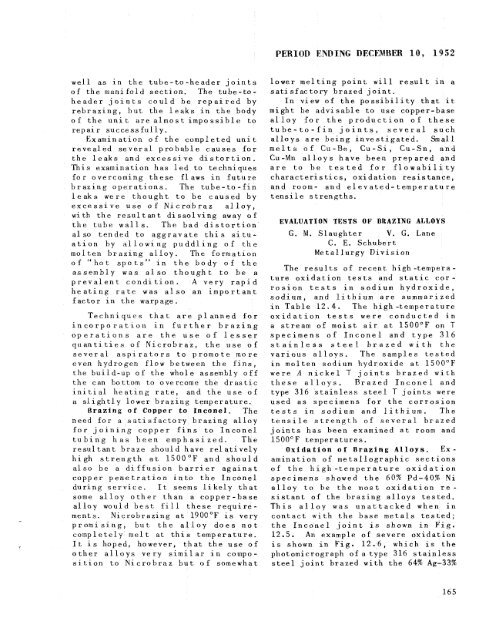the Molten Salt Energy Technologies Web Site
the Molten Salt Energy Technologies Web Site
the Molten Salt Energy Technologies Web Site
You also want an ePaper? Increase the reach of your titles
YUMPU automatically turns print PDFs into web optimized ePapers that Google loves.
well as in <strong>the</strong> tube-to-header joints<br />
of <strong>the</strong> manifold section. The tube-to-<br />
header joint,s could be repaired by<br />
rebrazing, but <strong>the</strong> leaks in <strong>the</strong> body<br />
of <strong>the</strong> unit are almost impossible to<br />
repair successfully.<br />
Examination of <strong>the</strong> completed unit,<br />
revealed several probable causes for<br />
<strong>the</strong> leaks and excessive distortion.<br />
This examination has led to techniques<br />
for overcoming <strong>the</strong>se flaws in future<br />
brazing operations. The tube-to-fin<br />
leaks were thought to be caused by<br />
excessive use of Nicrohraz alloy,<br />
with <strong>the</strong> resultant dissolving away of<br />
<strong>the</strong> tube walls. The bad distortion<br />
a1 so tended to aggravate this situ-<br />
ation by allowing puddling of <strong>the</strong><br />
molten brazing alloy. The formation<br />
of "hot spots" in <strong>the</strong> body of <strong>the</strong><br />
assembly was also thought to he a<br />
prevalent condition. A very rapid<br />
heating rate was also an important<br />
factor in <strong>the</strong> warpage.<br />
Techniqucs that are planned for<br />
incorporation in fur<strong>the</strong>r brazing<br />
operations are <strong>the</strong> use of lesser<br />
quantities of Nicrobraz, <strong>the</strong> use of<br />
several aspirators to promote more<br />
even hydragen flow between <strong>the</strong> €ins,<br />
<strong>the</strong> build-up of <strong>the</strong> whole assembly off<br />
<strong>the</strong> can hottom to overcome <strong>the</strong> drastic<br />
initial heating rate, and <strong>the</strong> use of<br />
a slightly lower brazing temperature.<br />
Brazing of Copper to Inconef, The<br />
need for a Satisfactory brazing alloy<br />
for joining copper fins to Inconel<br />
tubing has been emphasized. The<br />
resultant braze should have relatively<br />
high strength at 1500°F and should<br />
also be a diffusion barrier against<br />
capper penetration into <strong>the</strong> Inconel<br />
during service. It seems likely that<br />
some alloy o<strong>the</strong>r than a copper-base<br />
alloy would best fill <strong>the</strong>se require-<br />
ments. Nicrobrazing at 1900°F is very<br />
promising, but <strong>the</strong> alloy does not<br />
completely me1 t at this temperature.<br />
It is hoped, however, that <strong>the</strong> use of<br />
o<strong>the</strong>r alloys very similar in compo-<br />
sition to Nicrobraz but of somewhat<br />
PERIOD ENQING DECEMBER 10, 1952<br />
lower melting point w i l l result in a<br />
satisfactory brazed joint.<br />
In view of <strong>the</strong> possibility that it<br />
might be advisable to use copper-base<br />
alloy for <strong>the</strong> production of <strong>the</strong>se<br />
tube-to-fin joints, several such<br />
alloys are being investigated. Small<br />
m e l t s of Cu-Re, Cu-Si, Cu-Sn, and<br />
Cu-Mn alloys have been prepared and<br />
are to be tested for flowability<br />
char act eri s ti c s , oxidation resistance ,<br />
and room- and elevated-temperature<br />
tensile strengths.<br />
EVALUATION TESTS OF BRAZING ALLOYS<br />
G. M. Slaughter Y. G. Lane<br />
C. E. Schubert<br />
Metallurgy Division<br />
The results of recent high -tempera -<br />
ture oxidation tests and static cor -<br />
rosion tests in sodium hydroxide,<br />
sodium, and lithium are summarized<br />
in Table 12.4. The high -temperature<br />
oxidation tests were conducted in<br />
a stream of moist air at 1500°F on T<br />
specimens of Inconel and type 316<br />
stainless steel brazed with <strong>the</strong><br />
various alloys. The samples tested<br />
in molten sodium hydroxide at 1500°F<br />
were A nickel T j oints brazed with<br />
<strong>the</strong>se alloys. Brazed Inconel and<br />
type 316 stainless steel T joints were<br />
used as specimens for <strong>the</strong> corrosion<br />
tests in sodium and lithium. The<br />
tensile strength of several brazed<br />
joints has been examined at, room and<br />
1500" F temper a tures.<br />
Oxidation of Brazing Alloys. Ex-<br />
amination of metallographic sections<br />
of <strong>the</strong> high -temperature oxidation<br />
specimens showed <strong>the</strong> 60% Pd-40% N i<br />
alloy to be <strong>the</strong> most oxidation re-<br />
sistant of <strong>the</strong> brazing alloys tested.<br />
This alloy was unattacked when in<br />
contact with <strong>the</strong> base metals tested;<br />
<strong>the</strong> Inconel joint is shown in Fig.<br />
12.5. An example of severe oxidation<br />
is shown in Fig. 12.6, which is <strong>the</strong><br />
photomicrograph ofatype 316 stainless<br />
steel joint brazed with <strong>the</strong> 64% Ag-33%<br />
L65



![Review of Molten Salt Reactor Physics Calculations [Disc 2]](https://img.yumpu.com/21979492/1/190x247/review-of-molten-salt-reactor-physics-calculations-disc-2.jpg?quality=85)












